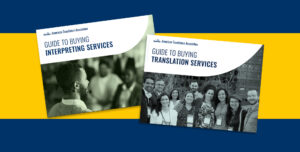Featured Articles
The ATA Chronicle offers current and relevant articles for business strategies.
Post-Reduction in Force: The World Is Moving On— I’m Still in Limbo
Layoffs are never easy—nor are they simple. They may stem from financial realities or strategic decisions handed down from leadership. Some come with warning; others arrive in a simple, impersonal email. However they unfold, they impact people’s lives and livelihoods—and nearly always stir fear, uncertainty, and grief. In this reflective essay, the author explores how to navigate these liminal spaces with presence, purpose, and compassion. What does it mean to rebuild after loss? And how do we, collectively, create a future that still feels worth getting up for in the morning?
Read MoreElevate Your Client Outreach with ATA’s Guides to Buying Translation and Interpreting Services!
Translators and interpreters help power the global economy, working with businesses, governments, nonprofits, and individuals. ATA’s guides to buying translation and interpreting services are resources created to help clients identify, select, and work with language professionals. Members can share these guides with existing and potential clients and others to educate them about the T&I professions.
Read MoreVetting Potential Clients
Even the best of us have been tempted by a scam. Technology has given scammers an unprecedented level of sophistication and access, making it easier than ever to be fooled. Here are some tips for fellow translators, interpreters, and language professionals to help them vet potential clients and avoid being scammed or left with unpaid invoices.
Read MoreFeatured Webinars
ATA's Webinar Series provides affordable and effective online education for business strategies.
Income – Expenses = Happiness: How to Be Happy in Your Business
Discover how to run a profitable business while staying happy and balanced. Learn how to connect with your passion, break limiting beliefs, and strengthen…
Read MoreLand the Job: Strategies for Interpreters and Translators (Part 3)
Gain practical tools and expert guidance tailored to help language professionals succeed in today’s competitive job market. This three-part webinar series is designed to…
Read MoreASTM F2575 Certification: What It Is, Why It Matters, and How to Prepare
Are you a language services provider owner curious about ASTM F2575 certification? Join this expert-led webinar for a practical look at the standard, the…
Read MoreDownload US CalPro
Do you know your operating costs, average hourly rate, or target income? US CalPro is a free spreadsheet that can put it all together for you.
Earnings Calculator
How much should you charge for your work? Calculate your potential earnings to find out.
Contracts and Agreements
ATA provides guidance for standard terms, conditions, and clauses. Adaptable samples are available for download.
Business Practices Community
Find real solutions to real issues facing freelancers and company owners.





